
Rise and Fall of Gary, Indiana
From Sand to Booming Industrial City to Ghost Town, The History of Gary Indiana
Overview:

From Sand to Steel:
From Sand to Steel:. Click to expand.
An introduction to Gary's Story and the rise and fall of this once busy city.

The U.S. Steel Gary Works:
The U.S. Steel Gary Works:. Click to expand.
History of the mill, its importtance to Gary and the starting point of Garys history.
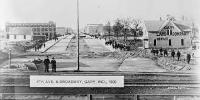
Gary Land Company Building:
Gary Land Company Building:. Click to expand.
First came the mill, then the town, created all by U.S. Steel the Land Company Building is where Gary's City buildings began
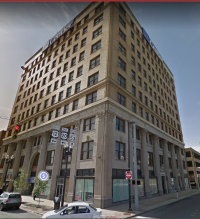
Rise of Housing and Classism:
Rise of Housing and Classism:. Click to expand.
As the city grew so did the red lining of the minorities. A preplanned city leading not only to a proper layout but a segregated city.

Gary Aquatprium (Bath House):
Gary Aquatprium (Bath House):. Click to expand.
As the city grows and homes and essentials have been created, The aquatorium was one of the first established public use buildings for the community.
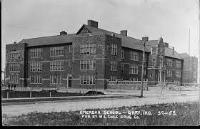
Emerson School Strike (1927):
Emerson School Strike (1927):. Click to expand.
As Gary is fully developed, the community isn't. The Emerson Strike was a display of the racism minority's dealt with throughout the community.
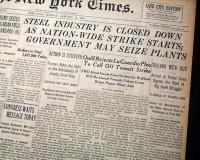
Steel Strikes (1946)
Steel Strikes (1946). Click to expand.
As inconsistancies in reliability for laborers to hold a job, low wages, high hours, and dangerous conditions, nationwide laborers went on strike from the middle 1940s to the early 1960s on and off to promote their union demands.

White Flight:
White Flight:. Click to expand.
With the steel industry demand decreasing and labor strikes many white people fled for the suburbs and neighboring cities for better job oppertunities.
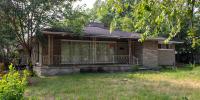
Mean Manor
Mean Manor. Click to expand.
A bond of brothers and a vision to help the black community these brothers provided housing through the midwest for reasonable prices.
From Sand to Steel:
Gary, IN was once a very desolate place where people wouldn't settle in because it was too far from the cities and there was no infrastructure built in the area. The idea of building a steel mill along the coast of lake Michigan for an easier and more cost-effective manner of shipping goods had brought to life the city that is Gary. The steel industry was the heart and soul of this small city. First came the mill, workers slept outside the facility, in tents and make-shift shacks as the town developed. The U.S Steel company provided many funds for the creation of the town. They had funded housing for the workers, a town hall, and many other buildings. Because of the U.S. Steel mill, Gary was able to grow from the ground up and flourish into a top producer of steel in the nation. Due to redlining Gary and racism integrated into the political structure of the city, created an unhealthy relationship between races and classes within the city. This ultimately led to the downfall of the city and abandonment of many buildings turning the town into a ghost town.
U.S Steel Gary Works:
Early Stages of the U.S. Steel Mill
This steel plant, still located in the original site, was one the highest-producing steel plants in the nation for a prolonged period. Construction of the mill finished in 190, opening for business. This plant had attracted ample amounts of laborers, leading to new developments outside of the industry (apartment complexes). During WWI the steel workers were made to work incredibly long hours, at a fast pace, in a dangerous industry. These laborers were underpaid and overused leading to the “Steel Strike of 1919”. Because of the strike the factory needed workers desperately. Out of desperation for laborers, Elbert Gary called for workers from the south and east of the U.S. causing many minorities to join the great migration to Gary, Indiana. With the original labor force on strike and WWI depleting the number of caucasian laborers, the number of available workers dropped drastically. Even with the migrants coming in from other states there were not enough people to staff this very large mill to full capacity. Elbert Gary's call out for laborers during the great migration, brought a dramatic change to Gary, IN’s demographics. Introductions of immigrants from Europe and immigrants from the south led to a change in the percentage of diversity in the city. Before the great migration immigrants and minorities consisted of around 8.8% of the population. After the migration that percentage went to 28.5% out of 30,000 employed, this is a large swing in the demographics of Gary over a few short years (U.S. Census Bureau). After this demographic change, Gary became one of the most ethnically diverse cities in the nation even though the population was not near that of popular cities at the time like NYC, Chicago, and Pittsburg.
Teal - Original Property Orange - Current Property Circles - U.S. Steel Housing
The Gary Land Company Building:
The Gary Land Company Building in it Original Location
The Gary Land Company Building has 3 stories to its lifetime. The first story deals with the erection of this building. U.S. Steel created a subsidiary company known as "The Land Company". The Land Company oversaw this preplanned city and the conception of the idea. This house was the first permanent building built in Gary Indiana after the mill was erected. This house is a 1 ½ story building, built in 1906. This building served as many things in its time, it served as a; city planning building, town hall, postal office, school, and businesses (U.S. National parks Department). (In chronological order, respectively.) Though the building was used for the community the Land Company still owned this building. The Land Company occupied the second floor of this building for the majority of its 1st story to be used for business purposes. During the first stage of this building's life, it had a major role in the construction of the city. The second story of its life has a less energetic use. After a few years of construction, the Land Company building needed to be moved for construction needs. This building was moved into a residential area for someone to live in. Samuel Witwer had become the owner of this building in 1909 (U.S. National parks Department). The third story of this building's life starts After Samuel Witwer passed away. The Historical Society obtained the building after the passing of Samuel Witwer and labeled it as a National Landmark just after the 50-year anniversary. The building was eventually turned into a museum, displaying the history of the town and the history of the city. It was decided that the building should be moved closer to the original site it was located in. The Land Company building was moved through the town yet again. Moving this building to its current location, it was placed as close to the original site as possible (U.S. National parks Department). The current location is across the street from the original location. The Gary Land Company Building was the first building in Gary and is currently the oldest surviving building still standing in Gary today. This building contributed to the construction of the city and housing for almost if not all the people who moved to Gary. The use of this building to create a city around the steel mill was a masterpiece of thoughtful planning that helped this city be home to one of the largest steel-producing mills in the nation. Though it does not seem like much, this building played a large part in helping create the city that flourished.
Red - 1st Location Green - 2nd Location Blue - 3rd Location
Rise of Housing and Classism:
5th Ave. and Broadway Apts.
During the beginning of Gary's creation, there was an influx of population without any housing. To solve this situation, they took Tomas Edison's never experimented idea for housing. It was a large-scale building containing small, roomed areas. This was the first use of the large-scale apartment complex. The need for housing quickly outweighed the want for decoration. The Company (The Land Company) used the early idea of Metaforming concrete to create these complexes. Because of the easy-to-use materials, there was no need to have experienced Masoners create the buildings (U.S. National Parks Department). For the working class, these buildings were put together very quickly, and cheaply, and they began deteriorating rapidly after construction. The city, when developed, intentionally had been developed in a way that divided the classes from each other due to the city being preplanned by the creator of the mill. Along with the division of class, this led to unintentional segregation in the community. Many minorities and immigrants didn't make nearly as much as their white colleagues. This led to white people in the more expensive neighborhoods while minorities and immigrants were pushed into the poor neighborhoods. The homes purchased by the management-level whites were constructed out of nicer materials and were significantly larger than any other residential area. They also had apartments, a historical landmark for the 5th St. Apartment complex has preserved the structure of the original building for the upper-class apartments. This structure was among the fanciest apartment structures in the city. Looking east of Broadway Ave. Were the middle-class to lower-class homes and apartment complexes. These small, residential buildings were a defining point of the mill's Lower-class management and high-up working class. The buildings were small, constructed with worse materials that the upper class but respectable nonetheless. These homes and apartments were suitable for single families rather than wealthy homes that could fit multiple families. Going south from Broadway Ave. We start to see the worst of the living situations. Because rent was so expensive in Gary, the working class containing mostly immigrants and minorities was located here. Before the Gary immigration, the large pink area in the middle of the maps was considered south. The wages for the working class were hardly enough to live off of before the 1919 strike. These homes that were for lower-class and poor individuals were typically made from whatever materials they could get ahold of. (All of the housing information has been provided by the housing of urban development) These living conditions were not the safest or the most hygienic. Living in the southern subdivision meant scraping by and living paycheck to paycheck. In modern-day Gary, IN these divisions of classes can be seen around town and later added decorative styles on the apartment buildings and shops downtown. This was done as a way to revamp the town's image from current perspectives.
Hand Created Map using Multimedia
An Overlay of a Satalite Map and the Housing Map. (Zone color determined by the banks willing to lend. ) Note the Blue and Green sections at the southern grouping and eastern grouping show 2nd wave of people migrating to Gary due to the Great Migration. The 1st grouping was from the people that had originally established Gary along with the Mill.
Hand Created Map using Multimedia
A Less Busy image depicting the housing based on Neighborhoods shows how the "Planned City" method is inherently segregation based on home prices pre-determined set by The Land Company Notice the population totals in the poorer neighborhoods are much larger than those of the upper-class neighborhoods. Take up relatively the same space in some neighborhoods comparatively the population in the upper class is less due to them owning more square feet per person than the poorer neighborhoods.
Gary Bathing Beach Aquatorium:
A city growing and developing from industrial productions Gary, IN was starting to grow beyond a steel production city. Gary was one of the top producers of steel in the nation. Because of their success in that industry, there was lots of money coming into the city. At this point in time, the city did not contain very many public places. The city was a predominantly privately owned area. The city was on the brink of changing from an industrial city to a stable modern-day functioning city. The missing piece of the city was the lack of public community-based areas. In the early 1920s, the Aquatorium was created. It was originally a bathhouse with different areas for different events. These events ranged from classical ballroom dancing to parties (City of Marquette). The Aquatorium was located in the sand dunes by the shore of lake Michigan. This bathhouse had access to a walk-out beachfront. With concerns about the beaches remaining public and not being overtaken by private owners, U.S. Steel had provided a generous donation. U.S. Steel had heard these concerns, and along with a healthy profit coming from the mill, they purchased over 100 acres that the bathhouse currently sits on and donated it (City of Marquette). This donation ensured that nobody could dispute the land because it was now owned privately but kept the property open to the public. After the bathhouse was shut down in the 60s, this landmark jumped on the top 10 list of endangered landmarks in Indiana. Eventually, this building got renovated from its decaying original structure into a Muti historical museum and event space. This renovated structure is now thriving along with the land it was gifted. The bathhouse and land eventually got renamed, Marquette Park. This park now holds the history of Peres Jacques Market; a French Jesuit who explored and mapped the region around the great lakes and the Mississippi tasked with the evangelization of the natives in the mid-1600s, and Octave Chanute a black French-born civil engineer that started testing the power of flight in the Indiana dunes, which led to the wright brother's advancements in flight. The interior of this renovated park hosts a museum of flight in Chanute's and the Tuskegee Airman’s honor.
Purple - Marquette Park Yellow - Aquatorium Location
On the Left Wing: A statue of Chaunte and his Biplane On the Right: A statue representing the Tuskegee Airmen and their iconic livery on the P-51 Mustang
Emerson School Strikes (1927):
Students of Emerson on Strike for Segregated Schools
Following the early years of Gary with the population skyrocketing and the new city popping up overnight, there were some decisions that needed to be made for education. Education in Gary was thought to be one of its greater achievements outside of the steel mill. During this time of a hustling city in full swing, the tensions between races in the city became directly proportional to the rise in population. With the rise in the population, many of the white and European foreigners were already in Gary. This meant that the black population was on the rise. With the integration of the KKK mixed in with the political decisions of the township for Gary. The establishment of the school system was written and designed for a segregated system. With this established separate but equal school system Emerson an all-white school was the only school that was strictly all-white. Froebel’s School and the Roosevelt School had allowed white in black students within the building but had separate premises for students. the schools that had separate wings for the black and white children often showed many signs of the white children picking on the black children in the school due to their race. Just because the politics were made to uphold the racism in Gary, does not mean there were not people trying to challenge the system. The designer of what is now a modern staple of today’s school system of work/study/play, William Wirt designed this school system first introduced in Gary, Indiana (Indiana History Bolg). With these schools being designated as segregated schools in the late 20s Wirt was a big believer in desegregation. Wirt found the idea to try and introduce 18 black students into a white school. Trying to start a new school year with a positive forward progressive thought. During the first days of school, many of the white children were confused about the black student’s attendance in the school because the school had a historically white student body with no black children ever attending the school. In the following days the students of Emerson, around 3,000, had formed a walkout and went on strike (Indiana History Blog). The strike continued for multiple days until the education board had to step in. The education board had talked with several students asking for their demands to get them to return to class. The one demand that was the same from every white student question was the same, "We want the black students out of the school." The education board finally came down to the decision to remove the black seniors attending Emerson high school and return them to their former schools. This failed attempt at trying to desegregate the community was not perceived well by the community. The blacks made up almost 40% of Gary’s population around this time the institutionalized racism throughout the white community was not allowing for any forward-thinking of desegregation of the schools at this time.
Capmus of Emerson High School when it was opened
Steel Strikes (1946):
Following the roaring twenties and the great depression came a significant moment in the history of the world. World War II came along just in time to reinvigorate the slowly dying steel industry. With WWII taking lots of labor at home to produce various items for the war the steel mill was one that didn't change. The steel mill continued to produce steel while hiring many more laborers to work 52-hour work weeks (St. James Encyclopedia of Labor History). Because of the expected increase in production laborers were being paid minimal wages while being worked to the bone. The profit-hungry industry decided to overwork and underpay their employees. This was a build-up to many frustrations of laborers toward management. After WWII steel like every other industry found itself at a decrease in production needs along with post-war inflation. This inflation had risen almost 16% in the time that laborers had gone on their first strike in the mid-1900s. The first strike was not only from laborers of steel production but almost every labor sector of the United States. Leading to a settlement of an 18-cent wage increase the steelworkers went back to work. At this time labor unions were starting to form. These unions protected the workers from the harsh management being pushed upon the laborers. With management disputing many different clauses from the labor unions contract for laborers many steelworkers had decided to go on strike again within a few years of the original strike demanding that management trying to limit their power is unconstitutional. With these accusations, U.S. steel was taken before the supreme court by laborers and union representatives to show how management was unconstitutional. Following the court proceedings, it was judged that U.S. Steel due to the introduction of the Harvey-Taft Act was within its rights to remove some items from the labor union contract (St. James Encyclopedia of Labor History). During the time of the trial and all of the labor strikes steel was needed, but it could not be produced at the rate needed due to a labor shortage. With a steel shortage from almost all steel mills in the U.S. The nation resorted to importing steel from international sources. With the new international market steel was being produced cheaper and of the same quality as that being produced in the states. The mass strikes from the steelworkers and other laborers opened the international market causing the downfall of labor jobs in the states. Now with more imports, and cheaper domestic prices mills had to lay off a significant portion of employees. The mass layoff had led to the well-known "white flight" those able to mainly white fled from Gary to the suburbs for better job opportunities. The white population was able to afford this move out of Gary while the minorities living paycheck to paycheck couldn't afford to move away, resulting in them getting trapped in Gary working various laborious jobs.
Location of the Steel Strike (1946)
White Flight:
The history of Gary, Indiana has had many factors that have led to the great migration of whites to the suburbs for many reasons contrary to popular belief it was not just a singular reason. Gary has been a city based on one industry since its development of the city, and because of this, there are benefits and drawbacks. The industry's being has a proportionate effect on the city. If the industry is doing well the city is also doing well and people are living well due to the fact that the majority of the people are employed in the industry. Alternatively, if the industry is doing poorly the welfare of the city is also doing poorly. This all changed when the white flight became more than just an idea. Due to the struggles of Gary's steel mill, many of the white population fled for the suburbs seeking better more reliable employment from other areas of Indiana. The minorities to poor, uneducated, or any other circumstance were unable to move away from Gary staying with the town and making the best of a bad situation. The demographics certainly changed in Gary, but so did many other aspects many people don't consider. "This often ignored aspect addresses other complex components such as lost property taxes, lost educational funding, and lost residents who flee for safer and brighter futures. (Spears, nwi)" With the loss of the top producers of tax money, the city lost a substantial budget within a concise time not allowing them to prepare their financial plans for the future. Due to the White Flight Gary lost a substantial portion of its city budget. With this loss, they had to focus on only the essentials to provide for the well-being of the people living in Gary. The city couldn't afford to keep up with abandoned buildings and repairs to places that were not being used. The Palace Theater and the Gary Methodist Church are some examples of the unfortunate outcome due to budgetary cuts. These were once the central life of the community (Indiana Historic Landmarks). Church in the morning promoted community togetherness, while the Palace Theater provided an endless stream of films and plays to promote the nightlife of Gary's once-busy city. These buildings were once an integral part of the city's culture. After budget cuts, the Church could not be repaired after the mass fire that destroyed it. The place had been shut down due to crime and resulting in the property being abandoned and run down to the point where the cost to repair the building was too much for the city to finance. While the city remains today with the mill functioning as the main job source for much of Gary, the city is not what it once was compared to its peak in the late 60s and early 70s.
Lines represent where the white population could ahve dispersed during the white flight
Mean Manor:
Mean Manor Before and After Community Clean-up
Due to White Flight Gary was left with a population half that of its prime. Not only was this a massive reduction in population. Many of the people who left, were white, hence the name "White Flight." Leaving Gary with a 78% population of African Americans from its previous 23%. Mean Manor was an answer for those living in Gary that needed affordable housing. Mean Manor home of Andrew Means, was also the center of his business. Andrew Mean was a skilled laborer who specialized in building homes. Andrew and his brother Geter had become the, "largest midwest African American real estate development companies. Helping those who needed affordable housing. (Swartz)" Mean Manor is located in the heart of the main African American neighborhood of Midtown. As blacks were segregated from downtown even after the legal ending of segregation caused a large localization of blacks in Midtown a close neighborhood to Downtown. The Mean brothers left their mark on history by being able to provide affordable housing to African Americans for many years. After years of abandonment, this building has become decrepit and overgrown by foliage. The city of Gary is a story of an industrial-oriented community moving into an empowerment community. The people of Gary empower each other and become a close society. This can be seen today at Mean Manor. Thanks to a group of volunteers from the area of Mean Manor this building got a facelift. Fixing up the landscape and clearing away the debris from the property has taken this historical home from an ugly eyesore to the community, to something to look at and reflect on the history it provides us with (Indiana Historic Landmarks). After years of neglect of the city due to a lacking budget from taxable income, all of Gary started to go downhill and decay. Just like Mean Manor, there have been beneficial acts to repair some buildings of historical and plans of revamping the city. With projects being started this city is on a path to regaining its former glory by transforming back into the city it was.
Mean Manor
Sources:
Images:
alamy. Alamy.com, 2022, c8.alamy.com/comp/RM903T/students-join-a-picket-line-with-teachers-in-gary-indiana-ca-1963-RM903T.jpg. Accessed 8 Dec. 2022.
Allaben, Laura. Gary, Indiana and the US Steel Corporation: An Examination of Gary, Indiana and the US Steel Corporation: An Examination of Race, Class, and Environmental Injustice in Early Twentieth Century Urban Planning. May 2021.
BeachyErin. “Aerial View of Gary, Indiana, 1911.” Images.indianahistory.org, 22 Mar. 2017, images.indianahistory.org/cdm/singleitem/collection/dc013/id/522/rec/4. Accessed 8 Dec. 2022.
City of Gary, Indiana. City of Gary COMPREHENSIVE PLAN 24 Photo Credit: Chicago Tribune. 2003.
---. “Visit Miller Beach.” Www.southshorecva.com, 2022, www.southshorecva.com/listing/visit-miller-beach/2997/. Accessed 8 Dec. 2022.
Harris, Chris. “The History and Legacy of Redlining in Greater Gary.” Ourgarystories, 13 Apr. 2021, www.ourgarystories.com/post/the-history-and-legacy-of-redlining-in-greater-gary. Accessed 8 Dec. 2022.
Indiana Landmarks. Indiana Landmarks. 2018, www.indianalandmarks.org/wp-content/uploads/2022/08/Geter-Means-House-header.jpg.
Nyttend. “American Sheet and Tin Mill Apartment Building.” Wikipedia, 31 Dec. 2021, en.wikipedia.org/wiki/American_Sheet_and_Tin_Mill_Apartment_Building#/media/File:American_Sheet_and_Tin_Mill_Apartment_Building.jpg. Accessed 8 Dec. 2022.
Ropeik, Annie. “Steelworker Death at U.S. Steel’s Gary Works Prompts Outcry.” WFYI Public Media, 5 Oct. 2016, www.wfyi.org/news/articles/steelworker-death-at-us-steels-gary-works-prompts-outcry.
Social List Worker. Socialistworker.org, 2022, socialistworker.org/sites/default/files/images/2011/07/gm-strike-1946jpg-4fbfafe88d242d5d.jpg. Accessed 8 Dec. 2022.
Steven. “The World War II and Post-War Strike Wave - Jeremy Brecher | Libcom.org.” Libcom.org, 7 Dec. 2019, libcom.org/article/world-war-ii-and-post-war-strike-wave-jeremy-brecher. Accessed 8 Dec. 2022.
Information:
“Andrew Means Park Manor,” Digital Civil Rights Museum, accessed December 8, 2022, https://www.digitalresearch.bsu.edu/digitalcivilrightsmuseum/items/show/76.
City Of Marquette, IN. 2010. “History of the Marquette Park - Gary, Indiana.” Marquetteparkgary.org. 2010. http://marquetteparkgary.org/park/.
Davich, Jerry. “JERRY DAVICH: Fear. Crime. White Flight. Racism. Lost Taxes. This Is What Happened to Gary.” Nwitimes.com, 24 Oct. 2022, www.nwitimes.com/news/jerry-davich-fear-crime-white-flight-racism-lost-taxes-this-is-what-happened-to-gary/article_e6e15313-862e-5e87-b8ff-e4ee40aa729e.html. Accessed 8 Dec. 2022.
Gary Public Library, “5th Avenue Apartments,” Discover Indiana, accessed October 27, 2022, https://publichistory.iupui.edu/items/show/607.
Gary Public Library and Jennifer Guiliano, Discover Indiana, “The Steel Strike of 1919 in Gary,” Discover Indiana, accessed October 27, 2022, https://publichistory.iupui.edu/items/show/603.
Gary Public Library and Rebecca Shrum, Discover Indiana, “The Emerson School Strike of 1927 in Gary,” Discover Indiana, accessed October 27, 2022, https://publichistory.iupui.edu/items/show/605.
Gary Public Library and Rebecca Shrum, Discover Indiana, “The Experience of Manual Laborers: At the Bottom of the Rail in Gary,” Discover Indiana, accessed October 27, 2022, https://publichistory.iupui.edu/items/show/604.
Gary Public Library, “Building a City for Workers,” Discover Indiana, accessed October 27, 2022, https://publichistory.iupui.edu/items/show/602.
Gary Public Library, “Construction of the Mill,” Discover Indiana, accessed October 27, 2022, https://publichistory.iupui.edu/items/show/600.
Gary Public Library, “If These Walls Could Talk: City Hall, Lake County Courthouse, and Gary’s Colorful Political History,” Discover Indiana, accessed October 27, 2022, https://publichistory.iupui.edu/items/show/608.
Gary Public Library, “Memorial Auditorium,” Discover Indiana, accessed October 27, 2022, https://publichistory.iupui.edu/items/show/606.
Historic American Buildings Survey, Creator. Gary Land Company Building, Gateway Park, Fourth Avenue & Penn Street moved from Broadway, Gary, Lake County, IN. Indiana Lake County Gary, 1933. Documentation Compiled After. Photograph. https://www.loc.gov/item/in0285/.
Indiana Historic Society. 2002. “Collection # P 0382.” https://indianahistory.org/wp-content/uploads/united-states-steel-corporation-gary-works.pdf.
Indiana University. 2010. “U.S. Steel Photograph Collection.” Webapp1.Dlib.indiana.edu. December 3, 2010. https://webapp1.dlib.indiana.edu/ussteel/index.jsp.
Landmarks, Indiana. “Volunteers Tackle Cleanup at Gary Neighborhood Landmark.” Indiana Landmarks, 28 July 2022, www.indianalandmarks.org/2022/07/volunteers-tackle-cleanup-at-gary-neighborhood-landmark/. Accessed 8 Dec. 2022.
National Parks Serice. 2022. “National Register Database and Research - National Register of Historic Places (U.S. National Park Service).” Www.nps.gov. June 28, 2022. https://www.nps.gov/subjects/nationalregister/database-research.htm#:~:text=The%20National%20Register%20of%20Historic.
Pfeiffer, Casey. “A Challenge to Integration: The Froebel School Strikes of 1945.” Indiana History Blog, Indiana Historical Bureau of the Indiana State Library, 17 Mar. 2017, blog.history.in.gov/a-challenge-to-integration-the-froebel-school-strikes-of-1945/. Accessed 8 Dec. 2022.
Rasmussen, Soren. Race and the Mobility of Capital and Labor in Gary, Indiana. 2016, chrome-extension://efaidnbmnnnibpcajpcglclefindmkaj/www.in.gov/history/files/Rausmussen-2016-paper.pdf. Accessed 8 Dec. 2022.
"Strike Wave: United States ." St. James Encyclopedia of Labor History Worldwide: Major Events in Labor History and Their Impact. . Encyclopedia.com. 29 Nov. 2022 <https://www.encyclopedia.com>.
United States Census Bureau. 2018. “The Great Migration, 1910 to 1970.” U.S. Census. 2018. https://www.census.gov/dataviz/visualizations/020/.
U.S. Department of Interior National Parks Service “National Register of Historic Places Registration Form," National Register of Historic Places: American Sheet and Tin Mill Apartment Building, August 2002), https://secure.in.gov/apps/dnr/shaard/r/27029/N/American_Sheet_and_Tin_Meill_Apt_Bldg_Lake_CO_Nom.pdf
U.S. Department of Interior National Parks Service “National Register of Historic Places Registration Form," National Register of Historic Places: Gary Land Company Building, March 14th, 1979), https://catalog.archives.gov/id/132003617
U.S. Department of Interior National Parks Service “National Register of Historic Places Registration Form," National Register of Historic Places: West 5th Ave. Apartments Historic District, October 24th, 1983), https://secure.in.gov/apps/dnr/shaard/r/1f3dc/N/West_5th_Ave_Apts_HD_Lake_CO_Nom.pdf